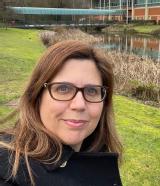Dr Jenny Spiga
How did your journey into Physics begin?
I studied Physics at the University of Cagliari in Italy. Specialising in Nuclear Physics, I joined the European Synchrotron Radiation Facility (ESRF) in Grenoble, France to conduct my final year project. I started my PhD at the ESRF’s biomedical beamline, working on Microbeam Radiation Therapy, an innovative preclinical radiotherapy technique. Using synchrotron radiation, MRT reduces the damage risk by delivering the dose via a parallel array of microscopic beams, as opposed to a single wide beam used in conventional radiotherapy. Preclinical studies show that the efficacy of MRT is due to the differential effect of the microbeam pattern on normal tissues and tumours, the first appearing to be more tolerant of such microscopic inhomogeneity of dose than tumours. This makes this therapy particularly suitable for radiosensitive areas, such as the brain, in which minimising damage is vital. Using computer simulations and experiments, my work consists in the optimisation of the parameters best suited to produce the desired dose profiles that maximise the MRT therapeutic benefit. I joined the Department of Physics in Warwick in 2017 as a Daphne Jackson Fellow after a career break to dedicate time to my young family, and I am now Assistant Professor (research focussed) in the same department.
How did your journey into science begin?
I have always been curious, keen to experiment and to discover. I had a natural ability in mathematics, and I’ve always liked to solve problems. By the time I reached high school, I knew that I wanted to do something with lots of maths in it, but I also wanted to do something that could have an impact on people. I had a very inspiring physics teacher, with whom I am still friends, who sparked my interest in Physics. When I started University my mum had breast cancer, and this played an important role in my decision to specialise in medical physics. Thanks to an Erasmus bursary, I spent 8 months at the ESRF, where they were researching a new radiotherapy technique to treat brain tumours in young children. Since then I became part of the team, and we hope to see this therapy employed in hospitals soon.
What is your favourite thing about your research area and working at Warwick?
I love the interdisciplinary nature of medical physics, and the fact that I am doing something to potentially help people. Warwick’s unique mix of collaborators across multiple disciplines makes it the ideal location for my research.
Why do you think it is important to highlight women and gender minorities in science? What does it mean to you?
Diversity influences the nature and process of knowledge production. Women are underrepresented in STEM disciplines, particularly at senior level, and very often need more support to reach their career goals. The Daphne Jackson Fellowship certainly gave me a willingness to help other women achieving their career dreams and receiving the same support I received when I needed. Since 2022 I collaborate to enhancing research culture projects in Warwick, to identify existent STEM-specific barriers and challenges, and propose solutions to overcome them.

